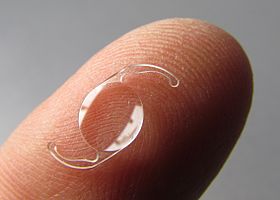Mr Sameer Trikha MBA FRCOphth

Cataract surgery has evolved tremendously over the past two decades to become the most safe and effective surgical procedure worldwide. Advances in intraocular lens (IOL) technology have now provided an array of options for patients undergoing this procedure.
There are, however, pros and cons for each option.
Traditionally, cataract surgery involves the replacement of the natural lens of the eye with a clear, monofocal (fixed distance) intraocular lens. Usually patients prefer clear ‘distance’ vision, meaning that they need help with near work using reading glasses. In patients with astigmatism (where the eye is shaped like a rugby ball) a ‘toric’ IOL can be offered, which can correct the irregularity. However, this again requires the use of glasses for near work. The benefits of such lenses mean that there is often 100% light transmission and excellent contrast sensitivity (assuming there is no other eye condition present). However, glasses are needed for near work nearly all of the time, which of course can be a nuisance.
So what are the options for spectacle free vision post cataract surgery?
A number of IOL’s are available which can permit very good near, intermediate and distance vision. This may be a particularly worthwhile option for patients with certain occupations, with a variety of visual needs, or for those who simply do not like the need for reading glasses. With these so-called ‘premium’ IOL’s, there is however a trade-off, in the sense that whilst such technology is getting better and better, it does not quite replicate the quality of vision we had when, for example, we were 21.
This is due in part to the creation of a lens that has different powers in different segments of it. Some lens platforms therefore trade off this additional functionality, at the expense of a small reduction in light transmission, and contrast sensitivity. In certain light conditions, some patients may experience glare, haloes around lights or starbursts. These are usually infrequent, and in general most patients are delighted with the spectacle independence that multifocal lenses give them.
In recent years Extended Depth of Focus (EdOF) lenses have also become available, allowing patients to receive excellent distance and intermediate vision, across a better range of distances. In general these lenses have slightly more light transmission compared to Multifocal, but near vision may require additional spectacle use.
With an array of options available to patients, it’s important to determine what the best options are to suit your needs. One option does not work for all.
I am always happy to discuss lens options following cataract surgery – please don’t hesitate to contact me at contact@sameertrikha.com to arrange a consultation.











